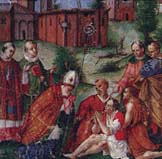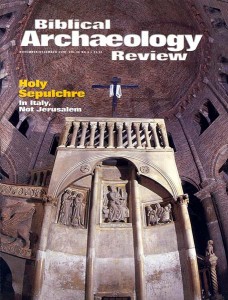Legendary Beginnings
Sidebar to: The Church of the Holy Sepulchre (in Bologna, Italy)

As patron saint and bishop (c. 432–450) of Bologna, San Petronio was credited with erecting some of his city’s most famous and enduring edifices. According to his Vita, or life story, in the fifth century Petronio traveled to the Holy Land, where, with only a reed as his tool, the saint took the measurements of the monuments commemorating Jesus’ life and death. On returning to Bologna, the Latin text records, the saint constructed a “monasterium in honore sancti Stephani” (a chapel, or monastery, in honor of Saint Stephen), modeled on the holy sites of Jerusalem. Today, this 12th-century Vita provides the first clear association of Santo Stefano with the fifth-century bishop. The Vita author believed that the building program of San Petronio must have been considerably grander and more lavish than the 12th-century complex, but that the organization and symbolism were the same.
An early-16th-century miniature (below left), by Giovanni Battista Cavalletto, depicts a miracle said to have taken place during the church construction. In the foreground, San Petronio, wearing a bishop’s miter and carrying a staff, heals a bricklayer who fell while working on the walls. Behind them stands the half-built church, rendered in careful detail (compare with the black-and-white photo, p. 28). The rotunda of Santo Sepolcro is complete. Just to the right, the Church of San Giovanni Battista lacks only its roof; its distinctive exterior pulpit has already been constructed.
Already a library member? Log in here.
Institution user? Log in with your IP address.

